Napoleon: Difference between revisions
remove legend |
Tpbradbury (talk | contribs) New image has no legend. Also has confusing description on image page with no reference to 1811. ce |
||
| Line 123: | Line 123: | ||
In 1805, Britain convinced Austria and Russia to join a Third Coalition against France. Napoleon knew the French fleet could not defeat the [[Royal Navy]] and had a plan to lure it away from the [[English Channel]]. The French navy would escape from the British blockades of Toulon and Brest and threaten to attack the West Indies, thus drawing-off the British defence of the [[Western Approaches]], in the hope a Franco-Spanish fleet could take control of the Channel long enough for French armies to cross and [[Napoleon's invasion of England|invade England]].<ref>McLynn 1998, p.321</ref> However, after defeat at the naval [[Battle of Cape Finisterre (1805)|Battle of Cape Finisterre]] and because Austria and Russia had prepared an invasion of France, Napoleon had to change his plans. |
In 1805, Britain convinced Austria and Russia to join a Third Coalition against France. Napoleon knew the French fleet could not defeat the [[Royal Navy]] and had a plan to lure it away from the [[English Channel]]. The French navy would escape from the British blockades of Toulon and Brest and threaten to attack the West Indies, thus drawing-off the British defence of the [[Western Approaches]], in the hope a Franco-Spanish fleet could take control of the Channel long enough for French armies to cross and [[Napoleon's invasion of England|invade England]].<ref>McLynn 1998, p.321</ref> However, after defeat at the naval [[Battle of Cape Finisterre (1805)|Battle of Cape Finisterre]] and because Austria and Russia had prepared an invasion of France, Napoleon had to change his plans. |
||
The newly formed [[Grande Armée]] secretly marched to Germany in a [[turning movement]], Napoleon's [[Ulm Campaign]], that encircled the Austrian forces and severed their lines of communication. On 20 October 1805, the French captured 30,000 prisoners at [[Battle of Ulm|Ulm]], though the next day Britain's victory at the [[Battle of Trafalgar]] meant the Royal Navy gained control of the seas. Six weeks later, on the first anniversary of his coronation, Napoleon defeated Austria and Russia at Austerlitz ending the Third Coalition; he commissioned the [[Arc de Triomphe]] to commemorate the victory. |
The newly formed [[Grande Armée]] secretly marched to Germany in a [[turning movement]], Napoleon's [[Ulm Campaign]], that encircled the Austrian forces and severed their lines of communication. On 20 October 1805, the French captured 30,000 prisoners at [[Battle of Ulm|Ulm]], though the next day Britain's victory at the [[Battle of Trafalgar]] meant the Royal Navy gained control of the seas. Six weeks later, on the first anniversary of his coronation, Napoleon defeated Austria and Russia at Austerlitz ending the Third Coalition; he commissioned the [[Arc de Triomphe]] to commemorate the victory. Again Austria had to sue for peace: the [[Peace of Pressburg]] led to the creation of the [[Confederation of the Rhine]] with Napoleon named as its ''[[Protector (title)|Protector]]''.<ref>Goetz 2005, p.301</ref> |
||
Frank McLynn suggests Napoleon was so successful at Austerlitz he lost touch with reality, and what used to be French foreign policy became a "personal Napoleonic one".<ref>McLynn 1998, p.350</ref> Vincent Cronin disagrees, stating Napoleon was not overly ambitious for himself, that "he embodied the ambitions of thirty million Frenchmen".<ref>Cronin 1994, p.344</ref> |
|||
[[Image:Napoleon-imperial-guard.png|thumb|upright|A cropped version of ''The Battle of Jena, Won by Napoleon'' by [[Horace Vernet]]: the depiction shows the informality between Napoleon and his soldiers]] |
[[Image:Napoleon-imperial-guard.png|thumb|upright|A cropped version of ''The Battle of Jena, Won by Napoleon'' by [[Horace Vernet]]: the depiction shows the informality between Napoleon and his soldiers]] |
||
| Line 144: | Line 145: | ||
Britain was the other member of the coalition. In addition to the Iberian Peninsula, the British planned to open another front in mainland Europe. However, Napoleon was able to rush reinforcements to Antwerp, due to Britain's inadequately organised [[Walcheren Campaign]].<ref>McLynn 1998, p.422</ref> Concurrently, Napoleon annexed the [[Papal States]] because of the Church's refusal to support the Continental System. Pius VII responded by [[excommunication|excommunicating]] the emperor and the Pope was then abducted by Napoleon's officers. Though Napoleon did not order his abduction, he did not order Pius' release either. The Pope was moved throughout Napoleon's territories, sometimes while ill, and Napoleon sent delegations to pressure him into issues including giving-up power and a new concordat with France. In 1810 Napoleon married the Austrian [[Marie Louise, Duchess of Parma]], following his divorce of Joséphine; this further strained his relations with the Church and thirteen cardinals were imprisoned for non-attendance at the marriage ceremony.<ref>McLynn 1998, p.470</ref> The Pope remained confined for 5 years, and did not return to Rome until May 1814.<ref>McLynn 1998, p.433-5</ref> |
Britain was the other member of the coalition. In addition to the Iberian Peninsula, the British planned to open another front in mainland Europe. However, Napoleon was able to rush reinforcements to Antwerp, due to Britain's inadequately organised [[Walcheren Campaign]].<ref>McLynn 1998, p.422</ref> Concurrently, Napoleon annexed the [[Papal States]] because of the Church's refusal to support the Continental System. Pius VII responded by [[excommunication|excommunicating]] the emperor and the Pope was then abducted by Napoleon's officers. Though Napoleon did not order his abduction, he did not order Pius' release either. The Pope was moved throughout Napoleon's territories, sometimes while ill, and Napoleon sent delegations to pressure him into issues including giving-up power and a new concordat with France. In 1810 Napoleon married the Austrian [[Marie Louise, Duchess of Parma]], following his divorce of Joséphine; this further strained his relations with the Church and thirteen cardinals were imprisoned for non-attendance at the marriage ceremony.<ref>McLynn 1998, p.470</ref> The Pope remained confined for 5 years, and did not return to Rome until May 1814.<ref>McLynn 1998, p.433-5</ref> |
||
[[ |
[[Image:Empire français 1811.gif|thumb|upright|French Empire at its greatest extent in 1811{{legend|#BF4901|French Empire}}{{legend|#E1A135|[[Client state]]s}}{{legend|#E9BD72|Allies}}]] |
||
Napoleon consented to one of his marshals - and long-term rival - [[Charles XIV John of Sweden|Bernadotte]], ascending to the Swedish throne in November 1810. Napoleon had indulged Bernadotte's indiscretions because he was married to [[Désirée Clary]], but came to regret sparing his life when Bernadotte later sided Sweden with France's enemies.<ref>McLynn 1998, p.472</ref> |
Napoleon consented to one of his marshals - and long-term rival - [[Charles XIV John of Sweden|Bernadotte]], ascending to the Swedish throne in November 1810. Napoleon had indulged Bernadotte's indiscretions because he was married to [[Désirée Clary]], but came to regret sparing his life when Bernadotte later sided Sweden with France's enemies.<ref>McLynn 1998, p.472</ref> |
||
Revision as of 13:37, 25 January 2009
| Napoleon I | |||||
|---|---|---|---|---|---|
| Emperor of the French; King of Italy, Mediator of the Swiss Confederation, Protector of the Confederation of the Rhine | |||||
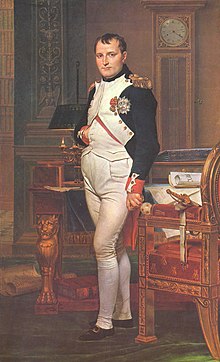 Napoleon by Jacques-Louis David (1812) | |||||
| Reign | 20 March 1804–6 April 1814 1 March 1815–22 June 1815 | ||||
| Coronation | 2 December 1804 | ||||
| Predecessor | French Consulate (Executive of the French First Republic, with Napoleon as First Consul); Previous ruling Monarch : Louis XVI as King of the French (died 1793) | ||||
| Successor | Louis XVIII (de facto) Napoleon II (de jure) | ||||
| Burial | Les Invalides, Paris | ||||
| Spouse | Joséphine de Beauharnais Marie Louise of Austria | ||||
| Issue | Napoleon II of France | ||||
| |||||
| Imperial House | Bonaparte | ||||
| Father | Carlo Buonaparte | ||||
| Mother | Letizia Ramolino | ||||
Napoleon Bonaparte (French: Napoléon Bonaparte French pronunciation: [napoleɔ̃ bɔnɑpaʁt]; 15 August 1769 – 5 May 1821) later known as Emperor Napoleon I, was a French military and political leader who is considered one of the most influential figures in European history.
Born in Corsica and trained as an artillery officer in mainland France, he rose to prominence under the First French Republic and led successful campaigns against the First and Second Coalitions arrayed against France. In 1799, Bonaparte staged a coup d'état and installed himself as First Consul; five years later he crowned himself Emperor of the French. In the first decade of the nineteenth century, he turned the armies of the French Empire against every major European power and dominated continental Europe through a series of military victories - epitomised in battles such as Austerlitz. He maintained France's sphere of influence by the formation of extensive alliances and the appointment of friends and family members to rule other European countries as French client states.
The French invasion of Russia in 1812 marked a turning point in Napoleon's fortunes. His Grande Armée was wrecked in the campaign and never fully recovered. In 1813, the Sixth Coalition defeated his forces at Leipzig; the following year the Coalition invaded France, forced Napoleon to abdicate and exiled him to the island of Elba. Less than a year later, he escaped Elba and returned to power, but was defeated at the Battle of Waterloo in June 1815. Napoleon spent the last six years of his life under British supervision on the island of Saint Helena, where he died. His autopsy concluded he died of stomach cancer, though Sten Forshufvud and other scientists have since conjectured that he had been poisoned with arsenic.
Napoleon scored major victories with a modernised French army and drew his tactics from different sources. His campaigns are studied at military academies the world over, and he is widely regarded as one of history's greatest commanders. While considered a tyrant by his opponents, he is also remembered for the establishment of the Napoleonic code, which laid the administrative and judicial foundations for much of Western Europe.
Origins and education
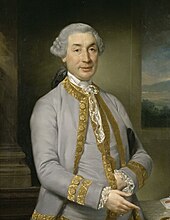
Napoleon Bonaparte was born the second of seven children in the town of Ajaccio, Corsica, on 15 August 1769, one year after the island was transferred to France by the Republic of Genoa.[1] He was initially named Napoleone di Buonaparte (in Corsican, Nabolione or Nabulione), though he later adopted the more French-sounding Napoléon Bonaparte.[note 1]
The Corsican Buonapartes originated from minor Italian nobility, which came to Corsica in the 16th century when the island was still a possession of Genoa.[2] His father Nobile Carlo Buonaparte, an attorney, was named Corsica's representative to the court of Louis XVI in 1777. The dominant influence of Napoleon's childhood was his mother, Maria Letizia Ramolino, whose firm discipline restrained the rambunctious child.[3] He had an elder brother, Joseph, and younger siblings Lucien, Elisa, Louis, Pauline, Caroline and Jérôme. Napoleon was baptised Catholic just before his second birthday, on 21 July 1771 at Ajaccio Cathedral.[4]
Napoleon's noble, moderately affluent background and family connections afforded him greater opportunities to study than were available to a typical Corsican of the time. In January 1779, Napoleon was enrolled at a religious school in Autun, mainland France, so as to learn French - in May he was admitted to a military academy at Brienne-le-Château.[5] He spoke with a marked Corsican accent and never learned to spell properly.[6] Napoleon was teased by other students for his accent and applied himself to study.[7][note 2] An examiner observed that he, "has always been distinguished for his application in mathematics. He is fairly well acquainted with history and geography...This boy would make an excellent sailor."[9][note 3] On completion of his studies at Brienne in 1784, Napoleon was admitted to the elite École Militaire in Paris ending his naval ambition, which had led him to consider joining the British Royal Navy.[11] Instead, he studied artillery and had to quickly complete the two-year course in one year, when his father's death reduced his income.[7] He was examined by the famed scientist Pierre-Simon Laplace whom Napoleon later raised to the Senate.[12]
Early career

On graduation in September 1785, Bonaparte was commissioned a second lieutenant in La Fère artillery regiment.[5][note 4] He served on garrison duty in Valence, Drôme and Auxonne until after the outbreak of the Revolution in 1789, though he took nearly two years of leave in Corsica and Paris during this period. A fervent Corsican nationalist, Bonaparte wrote to Pasquale Paoli, the Corsican leader, in May 1789: "As the nation was perishing I was born. Thirty thousand Frenchmen were vomited on to our shores, drowning the throne of liberty in waves of blood. Such was the odious sight which was the first to strike me."[13] He spent the early years of the Revolution in Corsica, amidst a complex three-way struggle between royalists, revolutionaries, and Corsican nationalists. He supported the Jacobin faction and gained the rank of Lieutenant Colonel of a battalion of volunteers. It is not clear how, after he had exceeded his leave of absence and led a riot against a French army in Corsica, he was able to convince military authorities in Paris to promote him to Captain in July 1792.[14] He returned to Corsica but came into conflict with Paoli, who had decided to split with France and sabotage a French assault on the Sardinian island of La Maddalena; Bonaparte was one of the assault leaders.[15]
Siege of Toulon
Bonaparte and his family had to flee to the French mainland in June 1793 due to the split with Paoli.[16] In July, Capitaine Napoléon Bonaparte published a pro-republican pamphlet, Le Souper de Beaucaire, which gained him the admiration and support of Augustin Robespierre, younger brother of the Revolutionary leader Maximilien Robespierre. With the help of fellow Corsican Antoine Christophe Saliceti, Bonaparte was appointed artillery commander of the French forces at the siege of Toulon. The city had risen in revolt against the republican government and was occupied by British troops.[17] He spotted an ideal hill placing that allowed French guns to dominate the city's harbour and force the British ships to evacuate. The assault on the position, during which Bonaparte was wounded in the thigh, led to the recapture of the city and his promotion to Brigadier General. His actions brought him to the attention of the Committee of Public Safety and he was given command of the artillery arm of France's Army of Italy.[18] During this period he became engaged to Désirée Clary, his future sister-in-law and whose father was a rich Marseille trader.[19]
13 Vendémiaire

Following the fall of the Robespierres in the July 1794 Thermidorian Reaction, Bonaparte was imprisoned for a few days at the Fort Carré d'Antibes in August 1794 for his association with the brothers. Although he was released after only ten days, he remained out of favour.[20] In April 1795, he was assigned to the Army of the West which was engaged in the War in the Vendée, a civil war and royalist counter-revolution in France's Vendée region. As this was an infantry command it was a demotion from the rank of artillery general and he pleaded poor health to avoid the posting.[21] He was moved to the Bureau of Topography of the Committee of Public Safety and sought unsuccessfully to get transferred to Constantinople. Running out of money, on 15 September he was removed from the list of generals in regular service following his transfer request.[22]
Three weeks later, royalists in Paris declared a rebellion against the National Convention after they were excluded from a new government, the Directory.[23] One of the leaders of the Thermidorian Reaction, Paul Barras knew of Bonaparte's military expertise and gave him command of the improvised forces that were defending the Convention in the Tuileries Palace where Bonaparte had witnessed the massacre of the Swiss Guards on 10 August 1792 and realised artillery would be key to defending the palace.[5] He ordered a young cavalry officer, Joachim Murat to seize big guns and used them to repel the attackers on 5 October 1795 - 13 vendémiaire an IV in the French Republican Calendar. 1,400 of the royalists died and the rest fled.[23] It has been frequently claimed Bonaparte later boasted he had cleared the streets with "a whiff of grapeshot", though this turn of phrase actually came from the historian Thomas Carlyle.[24]
The defeat of the Royalist insurrection extinguished the threat to the Convention and earned Bonaparte sudden fame, wealth, and the patronage of the new Directory. Murat would later become his brother-in-law. Bonaparte was promoted to Commander of the Interior and then given command of the Army of Italy.[16] Within weeks of Vendémiaire he was romantically attached to Barras's former mistress, Joséphine de Beauharnais, whom he married on 9 March 1796, after breaking his engagement to Désirée Clary.[25]
First Italian campaign
Two days after the marriage, Bonaparte left Paris to take command of the Army of Italy and led it on a successful invasion of Italy. At the Battle of Lodi he defeated Austrian forces, then drove them out of Lombardy.[16] He was defeated at Caldiero by Austrian reinforcements, led by József Alvinczi, though he regained the initiative at the crucial Battle of the Bridge of Arcole and proceeded to subdue the Papal States.[26] Bonaparte argued against the wishes of Directory atheists, such as Louis-Marie de La Reveillière-Lépeaux, to march on Rome and dethrone the Pope as he reasoned this would create a power vacuum that would be exploited by the Kingdom of Naples. Instead, in March 1797, Bonaparte led his army into Austria and forced it to sue for peace.[27] The Treaty of Leoben gave France control of most of northern Italy and the Low Countries; a secret clause promised the Republic of Venice to Austria. Bonaparte then marched on Venice and forced its surrender, ending 1,100 years of independence. He authorised the French to loot treasures such as the Horses of Saint Mark.[28]

His application of conventional military ideas to real-world situations effected his military triumphs, such as creative use of artillery as a mobile force to support his infantry. He referred to his tactics thus: "I have fought sixty battles and I have learned nothing which I did not know at the beginning. Look at Caesar; he fought the first like the last."[29] Contemporary paintings of his headquarters during the Italian campaign depict his use of the Claude Chappe semaphore line, first implemented in 1792. He was adept at both espionage and deception; he often won battles by his use of spies to gather information about enemy forces, concealment of troop deployments and concentration of his forces on the 'hinge' of an enemy's weakened front. If he could not use his favourite enveloping strategy, he would take-up the central position and attack two cooperating forces at their hinge, swinging around to fight one until it fled, then turning to face the other.[30] In this campaign, Bonaparte's army captured 150,000 prisoners, 540 cannons and 170 standards.[31] A year's campaign had seen the French army fight 67 actions and win 18 pitched battles due to superior artillery technology and Bonaparte's tactics and strategy.[32]
During the campaign, Bonaparte became increasingly influential in French politics. He published two newspapers, ostensibly for the troops in his army, but widely circulated in France as well. In May 1797, he founded a third newspaper, published in Paris, Le Journal de Bonaparte et des hommes vertueux.[33] Elections in mid-1797 gave the royalist party increased power which alarmed Barras and his Directory allies.[34] The royalists attacked Bonaparte for looting Italy and claimed he had overstepped his authority in dealings with the Austrians. Bonaparte sent General Pierre Augereau to Paris to lead a coup d'état and purge the royalists on 4 September - 18 Fructidor. This left Barras and his Republican allies in control again, but dependent on Bonaparte who proceeded to peace negotiations with Austria, the Treaty of Campo Formio, then returned to Paris in December as the conquering hero, more popular than the Directors.[35] He met with Talleyrand, France's new Foreign Minister - who would later serve in the same capacity for Emperor Napoleon - and they began to prepare for an invasion of England.[16]
Egyptian expedition
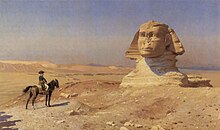
After two months of planning, Bonaparte decided France's naval power was not yet strong enough to confront the Royal Navy in the La Manche and proposed a military expedition to seize Egypt and thereby undermine Britain's access to its trading interests in India.[16] The Directory, though troubled by the scope and cost of the enterprise, agreed so the popular general would be absent from the centre of power.[36]
In May 1798, Bonaparte was elected a member of the French Academy of Sciences. His Egyptian expedition included a group of 167 scientists: mathematicians, naturalists, chemists and geodesers among them; their discoveries included the Rosetta Stone and their work was published in the Description of Egypt in 1809.[37] Ahmed Youssef writes that this deployment of intellectual resources was an indication of Bonaparte's devotion to Enlightenment principles; Juan Cole sees it as propaganda, which obfuscated imperialism.[38]
En route to Egypt, Bonaparte reached Malta on 9 June 1798. The 200 Knights Hospitaller of French origin did not support the Grand Master, Prussian Ferdinand von Hompesch zu Bolheim, who had succeeded a Frenchman and made it clear they would not fight against their compatriots. Hompesch surrendered after token resistance and Bonaparte captured a very important naval base with the loss of only three men.[39]
General Bonaparte and his expedition eluded pursuit by the British Royal Navy and on 1 July landed at Alexandria.[16] In a largely unsuccessful effort to gain the support of the Egyptian populace, Bonaparte issued proclamations that cast him as a liberator of the people from Ottoman oppression, Egypt was a province of the Ottoman Empire, and praised the precepts of Islam. In a letter to a sheikh in August 1798, Napoleon wrote, "I hope...I shall be able to unite all the wise and educated men of all the countries and establish a uniform regime based on the principles of the Quran which alone are true and which alone can lead men to happiness."[40] Though Bonaparte's secretary Bourienne, wrote that his employer had no serious interest in Islam or any other religion beyond their political value.[note 5]

Bonaparte successfully fought the Battle of Chobrakit against the Mamluks, an old power in the Middle East. This helped the French plan their attack in the Battle of the Pyramids fought over a week later, about 6 km from the pyramids. General Bonaparte's forces were greatly outnumbered by the Mamluks' cavalry - 20,000 against 60,000 - he formed hollow squares with supplies kept safely inside. 300 French and approximately 6,000 Egyptians were killed.[42]
On 1 August, the British fleet under Horatio Nelson captured or destroyed all but two French vessels in the Battle of the Nile and Bonaparte's goal of a strengthened French position in the Mediterranean Sea was frustrated.[43] His army had succeeded in temporarily increasing French power in Egypt, though it faced repeated uprisings.[44] In early 1799, he moved the army into the Ottoman province of Damascus (Syria and Galilee). Bonaparte led 13,000 French soldiers in the conquest of the coastal towns of Arish, Gaza, Jaffa, and Haifa.[45] The storming of Jaffa was particularly brutal: Bonaparte, on discovering many of them were former prisoners ostensibly on parole, ordered the garrison and 1,400 prisoners to be executed by bayonet or drowning to save bullets.[43] Men, women and children were robbed and murdered for three days.[46]
With his army weakened by disease - mostly bubonic plague - and poor supplies, Bonaparte was unable to reduce the fortress of Acre, and returned to Egypt in May.[43] To speed up the retreat, he ordered plague-stricken men to be poisoned.[47] Historians have argued this decision was necessary given the continued harassment of stragglers by Ottoman forces and those left behind alive were indeed tortured and beheaded by the Ottomans. Back in Egypt, on 25 July, Bonaparte defeated an Ottoman amphibious invasion at Abukir.[48]
Ruler of France
While in Egypt, Bonaparte stayed informed of European affairs through irregular delivery of newspapers and dispatches. He learnt France had suffered a series of defeats in the War of the Second Coalition.[49] On 24 August 1799, he took advantage of the temporary departure of British ships from French coastal ports and set sail for France, despite the fact he had received no explicit orders from Paris.[43] The army was left in the charge of Jean Baptiste Kléber.[50] Unknown to Bonaparte, the Directory had sent him orders to return to ward off possible invasions of French soil but poor lines of communication meant the messages had failed to reach the French general.[49] By the time he reached Paris in October, France's situation had been improved by a series of victories. The Republic was bankrupt however, and the ineffective Directory was unpopular with the French population.[51] The Directory discussed Bonaparte's "desertion" but was too weak to punish him.[49]

Bonaparte was approached by one of the Directors, Emmanuel Joseph Sieyès, for his support in a coup to overthrow the constitutional government. The leaders of the plot included his brother Lucien Bonaparte, the speaker of the Council of Five Hundred, Roger Ducos, another Director, Joseph Fouché and Talleyrand. On 9 November - 18 Brumaire - Bonaparte was charged with the safety of the legislative councils, who were persuaded to remove to the Château de Saint-Cloud, to the west of Paris, after a rumour of a Jacobin rebellion was spread by the plotters.[52] By the following day, the deputies had realised they faced an attempted coup. Faced with their remonstrations, Bonaparte led troops to seize control and disperse them, which left a rump legislature to name Bonaparte, Sièyes, and Ducos as provisional Consuls to administer the government.[43]
Though Sieyès expected to dominate the new regime, he was outmaneuvered by Bonaparte, who drafted the Constitution of the Year VIII and secured his own election as First Consul.[53] This made Bonaparte the most powerful person in France and he moved into the Tuileries Palace.[43] His powers were increased by the Constitution of the Year X including: Article 1. The French people name, and the Senate proclaims Napoleon-Bonaparte First Consul for Life.[54] After this he was generally referred to as Napoleon rather than Bonaparte.[55]
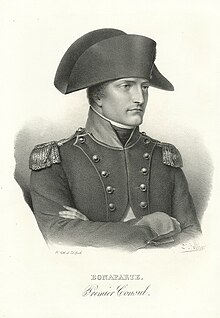
French Consulate
Bonaparte instituted lasting reforms, including centralised administration of the départements, higher education, a tax code, road and sewer systems and the Banque de France - the country's central bank. He negotiated the Concordat of 1801 with the Catholic Church, which sought to reconcile the mostly Catholic population to his regime. It was presented alongside the Organic Articles, which regulated public worship in France. In May 1802, he instituted the Légion d'Honneur, an ostensibly meritocratic honour system, to encourage civilian and military achievements and offset the inequality of wealth amongst the population. The order is still the highest decoration in France.[56]
Bonaparte's set of civil laws, the Code Civil - now known as the Napoleonic code - was prepared by committees of legal experts under the supervision of Jean Jacques Régis de Cambacérès, the Second Consul. Bonaparte participated actively in the sessions of the Council of State that revised the drafts. The development of the Code was a fundamental change in the nature of the civil law legal system with its stress on clearly written and accessible law. Other codes were commissioned by Napoleon to codify criminal and commerce law; in 1808, a Code of Criminal Instruction was published, which enacted rules of due process.[57] See Legacy.
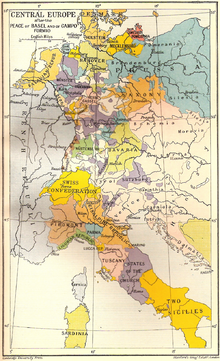
Second Italian campaign
In 1800, Bonaparte returned to Italy, which the Austrians had reconquered during his absence in Egypt. With his troops he crossed the Alps on a mule, as depicted in Bonaparte Crossing the Alps by Hippolyte Delaroche, and not on a charger as he appears in Jacques-Louis David's Napoleon Crossing the Alps.[58]
Though the campaign began badly, Bonaparte's forces routed the Austrians in June at the Battle of Marengo, which resulted in an armistice. His brother Joseph Bonaparte led the peace negotiations in Lunéville and reported that Austria, emboldened by British backing, would not recognise France's newly gained territory. As negotiations became increasingly fractious, Bonaparte gave orders to his general Moreau to strike Austria once more. Moreau led France to victory at Hohenlinden. As a result, the Treaty of Lunéville was signed in February 1801: the French gains of the Treaty of Campo Formio were reaffirmed and increased. Later that year, Bonaparte became President of the French Academy of Sciences and appointed Jean Baptiste Joseph Delambre its Permanent Secretary.[37] He re-established slavery in France's colonial possessions, where it had been banned following the Revolution.[59]
Temporary peace in Europe, the Haitian Revolution and the Louisiana Purchase
Bonaparte set up a camp at Boulogne to prepare for an invasion of Britain but both countries had become tired of war and signed the Treaty of Amiens in October 1801 and March 1802; this included the withdrawal of British troops from most colonial territories recently occupied.[60] The peace was uneasy and short-lived; Britain failed to evacuate Malta as promised and protested against Bonaparte's annexation of Piedmont and his Act of Mediation, which established a new Swiss Confederation, though neither of these territories were covered by the Treaty.[61] The dispute culminated in a declaration of war by Britain in May 1803, and Napoleon reassembled the invasion camp at Boulogne.[43]
Concurrently, Bonaparte faced a major setback and eventual defeat in the Haitian Revolution. Following a slave revolt, he sent an army to reconquer Saint-Domingue and establish a base. The force was, however, destroyed by yellow fever and fierce resistance led by Haitian generals Toussaint Louverture and Jean-Jacques Dessalines.[note 6] Faced by imminent war against Britain and bankruptcy, he recognised French possessions on the mainland of North America would be indefensible and sold them to the United States - the Louisiana Purchase - for less than three cents per acre ($7.40 per km²).[63]
French Empire

Napoleon faced royalist and Jacobin plots as France's ruler, including the 'Conspiration des poignards' (Daggers conspiracy) in October 1800 and the Plot of the Rue Saint-Nicaise two months later.[64] In January 1804, his police uncovered an assassination plot against him involving Moreau, ostensibly sponsored by the Bourbon former rulers of France. On the advice of Talleyrand, Napoleon ordered the kidnapping of the Duke of Enghien, in violation of neighbouring Baden's sovereignty. After a secret trial the Duke was executed, even though he had not been involved in the plot.[65]
Napoleon used the plot to justify the re-creation of a hereditary monarchy in France, with himself as Emperor, as a Bourbon restoration would be more difficult if the Bonapartist succession was entrenched in the constitution.[66] Napoleon crowned himself Emperor Napoleon I on 2 December 1804 at Notre Dame de Paris and then crowned Joséphine Empress.[note 7] He created eighteen Marshals of the Empire from amongst his top generals, to secure the allegiance of the army. Ludwig van Beethoven, a long-time admirer and disappointed at this turn towards imperialism, scratched his dedication to Napoleon from his 3rd Symphony.[66]
War of the Third Coalition
In 1805, Britain convinced Austria and Russia to join a Third Coalition against France. Napoleon knew the French fleet could not defeat the Royal Navy and had a plan to lure it away from the English Channel. The French navy would escape from the British blockades of Toulon and Brest and threaten to attack the West Indies, thus drawing-off the British defence of the Western Approaches, in the hope a Franco-Spanish fleet could take control of the Channel long enough for French armies to cross and invade England.[67] However, after defeat at the naval Battle of Cape Finisterre and because Austria and Russia had prepared an invasion of France, Napoleon had to change his plans.
The newly formed Grande Armée secretly marched to Germany in a turning movement, Napoleon's Ulm Campaign, that encircled the Austrian forces and severed their lines of communication. On 20 October 1805, the French captured 30,000 prisoners at Ulm, though the next day Britain's victory at the Battle of Trafalgar meant the Royal Navy gained control of the seas. Six weeks later, on the first anniversary of his coronation, Napoleon defeated Austria and Russia at Austerlitz ending the Third Coalition; he commissioned the Arc de Triomphe to commemorate the victory. Again Austria had to sue for peace: the Peace of Pressburg led to the creation of the Confederation of the Rhine with Napoleon named as its Protector.[68]
Frank McLynn suggests Napoleon was so successful at Austerlitz he lost touch with reality, and what used to be French foreign policy became a "personal Napoleonic one".[69] Vincent Cronin disagrees, stating Napoleon was not overly ambitious for himself, that "he embodied the ambitions of thirty million Frenchmen".[70]
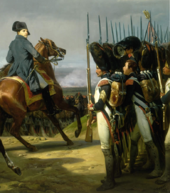
War of the Fourth Coalition
The Fourth Coalition was assembled the following year, and Napoleon defeated Prussia at the Battle of Jena-Auerstedt in October.[71] He marched against advancing Russian armies through Poland, and was involved in the bloody stalemate of the Battle of Eylau on 6 February 1807. After a decisive victory at Friedland, he signed the Treaties of Tilsit with Tsar Alexander I of Russia which divided the continent between the two powers. He placed puppet rulers on the thrones of German states, including his brother Jerome as king of the new Kingdom of Westphalia. In the French-controlled part of Poland, he established the Duchy of Warsaw with King Frederick Augustus I of Saxony as ruler.[72]
With his Milan and Berlin Decrees, Napoleon attempted to enforce a Europe-wide commercial boycott of Britain called the Continental System. This act of economic warfare did not succeed, as it encouraged British merchants to smuggle into continental Europe and Napoleon's exclusively land-based customs enforcers could not stop them.[73]
Peninsular War
Portugal did not comply with the Continental System so, in 1807, Napoleon invaded with the support of Spain. Under the pretext of a reinforcement of the Franco-Spanish army occupying Portugal, Napoleon invaded Spain as well, replaced Charles IV with his brother Joseph and placed his brother-in-law Joachim Murat in Joseph's stead at Naples. This led to resistance from the Spanish army and civilians in the Dos de Mayo Uprising.[74] Following a French retreat from much of the country, Napoleon took command and defeated the Spanish army, retook Madrid and then outmanoeuvred a British army sent to support the Spanish, driving it to the coast.[75] Before the Spanish population had been fully subdued, Austria again threatened war and Napoleon returned to France.
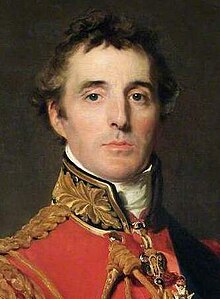
The costly and often brutal Peninsular War continued; in the second Siege of Saragossa most of the city was destroyed and over 50,000 people perished.[76] Napoleon left 300,000 of his finest troops to battle Spanish guerrillas as well as British and Portuguese forces commanded by Arthur Wellesley, 1st Duke of Wellington.[77] French control over the peninsular deteriorated and following several allied victories, the war concluded after Napoleon's abdication in 1814.[78]
War of the Fifth Coalition and remarriage
In April 1809, Austria abruptly broke its alliance with France and Napoleon was forced to assume command of forces on the Danube and German fronts. After early successes, the French faced difficulties in crossing the Danube and then suffered a defeat in May at the Battle of Aspern-Essling near Vienna. The Austrians failed to capitalise on the situation and allowed Napoleon's forces to regroup. He defeated the Austrians again at Wagram and a new peace, Treaty of Schönbrunn, was signed between Austria and France.[79]
Britain was the other member of the coalition. In addition to the Iberian Peninsula, the British planned to open another front in mainland Europe. However, Napoleon was able to rush reinforcements to Antwerp, due to Britain's inadequately organised Walcheren Campaign.[80] Concurrently, Napoleon annexed the Papal States because of the Church's refusal to support the Continental System. Pius VII responded by excommunicating the emperor and the Pope was then abducted by Napoleon's officers. Though Napoleon did not order his abduction, he did not order Pius' release either. The Pope was moved throughout Napoleon's territories, sometimes while ill, and Napoleon sent delegations to pressure him into issues including giving-up power and a new concordat with France. In 1810 Napoleon married the Austrian Marie Louise, Duchess of Parma, following his divorce of Joséphine; this further strained his relations with the Church and thirteen cardinals were imprisoned for non-attendance at the marriage ceremony.[81] The Pope remained confined for 5 years, and did not return to Rome until May 1814.[82]

Napoleon consented to one of his marshals - and long-term rival - Bernadotte, ascending to the Swedish throne in November 1810. Napoleon had indulged Bernadotte's indiscretions because he was married to Désirée Clary, but came to regret sparing his life when Bernadotte later sided Sweden with France's enemies.[83]
Invasion of Russia
The Congress of Erfurt sought to preserve the Russo-French alliance and the leaders had a friendly personal relationship after their first meeting at Tilsit in 1807.[84] By 1811, however, tensions were building between the two nations and Alexander was under pressure from the Russian nobility to break off the alliance. The first clear sign the alliance was deteriorating was the relaxation of the Continental System in Russia, which angered Napoleon.[85] By 1812, advisers to Alexander suggested the possibility of an invasion of the French Empire and the recapture of Poland. On receipt of intelligence reports on Russia's war preparations, Napoleon expanded his Grande Armée to more than 450,000 men, in addition to at least 300,000 men already deployed in Iberia. Napoleon ignored repeated advice against an invasion of the vast Russian heartland, and prepared for an offensive campaign; on 23 June 1812, his invasion of Russia commenced.[86]
In an attempt to gain increased support from Polish nationalists and patriots, Napoleon termed the war the "Second Polish War."[note 8] Napoleon rejected requests to free the Russian serfs, due to concerns this might provoke a reaction in his army's rear.
The Russians avoided Napoleon's objective of a decisive engagement and instead retreated deeper into Russia. A brief attempt at resistance was made at Smolensk in August; the Russians were defeated in a series of battles and Napoleon resumed his advance. The Russians then repeatedly avoided battle, although in a few cases this was only achieved because Napoleon uncharacteristically hesitated to attack when the opportunity arose. Due to the Russian army's scorched earth tactics, the French found it increasingly difficult to forage food for themselves and their horses.[87] The French also suffered from the harsh Russian winter.
The Russians eventually offered battle outside Moscow on 7 September: the Battle of Borodino resulted in approximately 44,000 Russian and 35,000 French, dead, wounded or captured, and may have been the bloodiest day of battle in history.[note 9] Although the French had won, the Russian army had accepted, and withstood, the major battle Napoleon had hoped would be decisive. Napoleon's own account was: "The most terrible of all my battles was the one before Moscow. The French showed themselves to be worthy of victory, but the Russians showed themselves worthy of being invincible."[88]
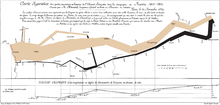
The Russian army withdrew and retreated past Moscow. Napoleon entered the city, assuming its fall would end the war and Alexander would negotiate peace. However, on orders of the city's military governor Fyodor Rostopchin, rather than capitulating, Moscow was ordered burned.[89] Within the month, concerned about loss of control back in France, Napoleon and his army left.
The French suffered greatly in the course of a ruinous retreat; the Armée had begun as over 450,000 frontline troops, but in the end fewer than 40,000 crossed the Berezina River in November 1812, to escape.[90] The strategy employed by the Russians had worn down the invaders: French losses in the campaign were about 570,000 in total.[91] The Russians lost 150,000 in battle and hundreds of thousands of civilians.[92]
War of the Sixth Coalition
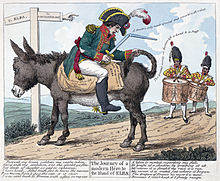
There was a lull in fighting over the winter of 1812–13 while both the Russians and the French rebuilt their forces; Napoleon was then able to field 350,000 troops.[93] Heartened by France's loss in Russia, Prussia rejoined Austria, Sweden, Russia, the UK, Spain, and Portugal. Napoleon assumed command in Germany and inflicted a series of defeats on the Coalition which culminated in the Battle of Dresden on 26–27 August 1813 - the battle resulted in 38,000 casualties for the Coalition and the French sustained around 10,000.[94] Despite these successes, the numbers continued to mount against Napoleon as Sweden and Austria joined the Coalition. Eventually the French army was pinned down by a force twice its size and lost at the Battle of Leipzig from 16–19 October. This was by far the largest battle of the Napoleonic Wars and cost more than 90,000 casualties in total.[95]
Napoleon withdrew back into France; his army was reduced to 70,000 soldiers and 40,000 stragglers, against more than three times as many Allied troops.[96] The French were surrounded: British armies pressed from the south, and other Coalition forces positioned to attack from the German states. Napoleon won a series of victories in the Six Days Campaign, though these were not significant enough to change the overall position and Paris was captured by the Coalition in March 1814.

When Napoleon proposed the army march on the capital, his marshals decided to mutiny.[97] On 4 April, led by Ney, they confronted Napoleon. Napoleon asserted the army would follow him and Ney replied the army would follow its generals. On 6 April, Napoleon abdicated in favour of his son, the Allies refused to accept this and demanded unconditional surrender. Napoleon abdicated unconditionally 5 days later. In the Treaty of Fontainebleau the victors exiled him to Elba, an island of 12,000 inhabitants in the Mediterranean Sea 20 km off the coast of Italy. They gave him sovereignty over the island and allowed him to retain his title of Emperor. Napoleon attempted suicide with a pill he had carried since a near capture by Russians on the retreat from Moscow. Its potency had weakened with age and he survived to be exiled, while his wife and son took refuge in Vienna.[98] In the first few months on Elba he created a small navy and army, developed the iron mines, and issued decrees modernising agricultural methods.[99]
Hundred Days
Separated from his wife and son (who had come under Austrian control), cut off from the allowance guaranteed to him by the Treaty of Fontainebleau, and aware of rumours he was about to be banished to a remote island in the Atlantic Ocean, Napoleon escaped from Elba on 26 February 1815. He landed at Golfe-Juan on the French mainland, two days later.[100] The 5th Regiment was sent to intercept him and made contact just south of Grenoble on 7 March 1815. Napoleon approached the regiment alone, dismounted his horse and, when he was within gunshot range shouted, "Here I am. Kill your Emperor, if you wish."[101] The soldiers responded with, "Vive L'Empereur!" and marched with Napoleon to Paris; Louis XVIII fled. On 13 March, the powers at the Congress of Vienna declared Napoleon an outlaw and four days later the UK, the Netherlands, Russia, Austria and Prussia bound themselves to put 150,000 men into the field to end his rule.[102] Napoleon arrived in Paris on 20 March and governed for a period called the Hundred Days. By the start of June the armed forces available to Napoleon had reached 200,000. Napoleon decided to go onto the offensive to attempt to drive a wedge between the oncoming British and Prussian armies: the French Army of the North crossed the frontier into the United Kingdom of the Netherlands, in modern-day Belgium.[103]

Napoleon's forces fought the allies, led by Wellington and Von Blücher, at the Battle of Waterloo on 18 June 1815. Wellington's army withstood repeated attacks by the French and drove them from the field while the Prussians arrived in force and broke through Napoleon's right flank. The French army left the battlefield in disorder, which allowed Coalition forces to enter France and restore Louis XVIII to the French throne. Off the port of Rochefort, Charente-Maritime, after quickly considering an escape to the United States, Napoleon formally demanded political asylum from the British Captain Frederick Maitland on HMS Bellerophon on 15 July 1815.[104]
Exile on Saint Helena
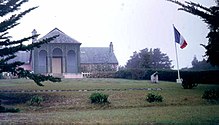
Napoleon was imprisoned and then exiled to the island of St. Helena in the Atlantic Ocean, 2,000 km from any major landmass. In his first 2 months there, he lived in a pavilion on the Briars estate, which belonged to a William Balcombe. Napoleon became friendly with his family, especially his younger daughter Lucia Elizabeth who later wrote Recollections of the Emperor Napoleon.[105] This friendship ended in 1818 when British authorities became suspicious that Balcombe had acted as an intermediary between Napoleon and Paris, and dismissed him from the island.[106]
Napoleon moved to Longwood House in December 1815. It had fallen into disrepair, and the location was damp, windswept and considered unhealthy even by the British.[107] With a small cadre of followers, Napoleon dictated his memoirs and criticised his captors - particularly Hudson Lowe, the British governor of the island and Napoleon's custodian. Lowe's treatment of Napoleon is regarded as poor by most historians, including Frank McLynn.[108] Lowe exacerbated a difficult situation through measures including a reduction in Napoleon's expenditure, a rule that no gifts could be delivered to him if they mentioned his imperial status, and a document that his supporters had to sign that guaranteed they would stay with the prisoner indefinitely.[108] Napoleon and his entourage did not accept the legality or justice of his captivity. In the early years of exile Napoleon received visitors but, as the restrictions placed on him were increased, his life became that of a recluse.
In 1818 The Times reported a false rumour of Napoleon's escape and said the news had been greeted by spontaneous illuminations in London.[note 10] There was sympathy for him in the British Parliament: Lord Holland gave a speech demanding the prisoner be treated with no unnecessary harshness.[110] Napoleon kept himself informed of the events through The Times and hoped for release in the event that Holland became Prime Minister. He also enjoyed the support of Lord Cochrane, who was involved in Chile and Brazil's struggle for independence and wanted to rescue Napoleon and help him set-up a new empire in South America, a scheme frustrated by Napoleon's death in 1821.[111] There were other plots to rescue Napoleon from captivity including one from Texas, where 400 exiled soldiers from the Grande Armée dreamed of a resurrection of the Napoleonic Empire in America. There was even a plan to rescue him with a submarine.[112] For Lord Byron, Napoleon was the epitome of the Romantic hero, the persecuted, lonely and flawed genius. The news that Napoleon had taken up gardening at Longwood appealed to more domestic British sensibilities.[113]
Death

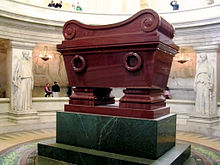
In February 1821, his health began to fail rapidly and on 3 May, two British physicians who had recently arrived, attended him and could only recommend palliatives.[114] He died two days later, having confessed his sins and received Extreme Unction and Viaticum at the hands of Father Ange Vignali.[114] His last words were, "France, armée, tête d'armée, Joséphine." ("France, army, head of the army, Joséphine.")[114] Napoleon's original death mask was created around 6 May, though it is not clear which doctor created it.[115][note 11] In his will he had asked to be buried on the banks of the Seine, but the British governor said he should be buried on St. Helena, in the "valley of the willows". Hudson Lowe insisted the inscription should read 'Napoleon Bonaparte', Montholon and Bertrand wanted the Imperial title 'Napoleon' as royalty were signed by their first names only. As a result the tomb was left nameless.[117]
In 1840, Louis-Philippe of France obtained permission from the British to return Napoleon's remains to France. The remains were transported aboard the frigate Belle-Poule, which had been painted black for the occasion and on 29 November she arrived in Cherbourg. The remains were transferred to the steamship Normandie, which transported them to Le Havre, up the Seine to Rouen and on to Paris. On 15 December a state funeral was held. The hearse proceeded from the Arc de Triomphe down the Champs-Elysees, across the Place de la Concorde to the Esplanade and then to the cupola in St Jerome's Chapel, where it stayed until the tomb designed by Louis Visconti was completed. In 1861 Napoleon's remains were entombed in a porphyry sarcophagus in the crypt under the dome at Les Invalides.[118][note 12] Hundreds of millions have since visited his tomb.
Cause of death
Napoleon's physician, Francesco Antommarchi, led the autopsy which found the cause of death to be stomach cancer, though he did not sign the official report, stating, "What had I to do with...English reports?"[119] Napoleon's father had died of stomach cancer though this was seemingly unknown at the time of the autopsy.[120] Antommarchi found evidence of a stomach ulcer and it was the most convenient explanation for the British who wanted to avoid criticism over their care of the Emperor.[114]

In 1955 the diaries of Napoleon's valet, Louis Marchand, appeared in print. His description of Napoleon in the months before his death led Sten Forshufvud to put forward other causes for his death, including deliberate arsenic poisoning, in a 1961 paper in Nature.[121][note 13] Arsenic was used as a poison during the era because it was undetectable when administered over a long period. Forshufvud, in a 1978 book with Ben Weider, noted the emperor's body was found to be remarkably well-preserved when moved in 1840. Arsenic is a strong preservative and therefore this supported the poisoning hypothesis. Forshufvud and Weider observed that Napoleon had attempted to quench abnormal thirst by drinking high levels of orgeat syrup that contained cyanide compounds in the almonds used for flavouring. They maintained that the potassium tartrate used in his treatment prevented his stomach from expelling these compounds and claimed the thirst was a symptom of poisoning. Their hypothesis was that the calomel given to Napoleon became an overdose, which killed him and left behind extensive tissue damage.[121] A 2007 article stated that the type of arsenic found in Napoleon's hair shafts was mineral type, the most toxic, and according to toxicologist Dr Patrick Kintz, this supported the conclusion that his death was murder.[123]
The wallpaper used in Longwood contained a high level of arsenic compound used for colouring by British manufacturers. The adhesive, which in the cooler British environment was innocuous, may have grown mold in the more humid climate and emitted the poisonous gas arsine. This theory has been ruled out, it does not explain the arsenic absorption patterns found in other analyses.[121]
There have been modern studies which have supported the original autopsy finding.[123] Researchers, in a 2008 study, analysed samples of Napoleon's hair from throughout his life, and from his family and other contemporaries. All samples had high levels of arsenic, approximately 100 times higher than the current average. According to these researchers, Napoleon's body was already heavily contaminated with arsenic as a boy, and the high arsenic concentration in his hair was not due to intentional poisoning; people were constantly exposed to arsenic from glues and dyes, throughout their lives.[note 14] A 2007 study found no evidence of arsenic poisoning in the relevant organs and concluded stomach cancer was the cause of death.[125]
Marriages and children


Napoleon married Joséphine in 1796, when he was 26; she was a 32-year old widow whose first husband had been executed during the revolution. Until she met Bonaparte, she had always been Rose, a name which he disliked. He called her 'Joséphine,' which she took up, and sent her love letters while on his campaigns.[126] He formally adopted her son Eugène and cousin Stéphanie, and arranged dynastic marriages for them. Joséphine had her daughter Hortense marry Napoleon's brother, Louis.[127]
Joséphine had lovers, including a Hussar lieutenant Hippolyte Charles during Napoleon's Italian campaign.[128] Napoleon learnt the full extent of the Charles' affair when in Egypt and a letter he wrote to Joseph confiding in him regarding the subject, was intercepted by the British. The letter appeared in the London and Paris press, much to Napoleon's embarrassment. Napoleon had his own affairs too: during the Egyptian campaign he took Pauline Bellisle Foures, the wife of a junior officer, as his mistress. She became known as "Cleopatra" after the Pharaoh ruler.[129]
While Napoleon's mistresses had children by him, Joséphine did not produce an heir, an impossibility due to the stresses of her imprisonment during the Terror or because she may have had an abortion in her twenties.[130] Napoleon ultimately decided to divorce so he could remarry in search of an heir. In March 1810, he married Marie Louise, Archduchess of Austria by proxy; he had married into the German royal family. They remained married until his death, though she did not join him in exile. The couple had one child Napoleon Francis Joseph Charles (1811–32), known from birth as the King of Rome. He later became Napoleon II, although he reigned for only two weeks. He was awarded the title of the Duke of Reichstadt in 1818 and died of tuberculosis aged 21, with no children.[131]
Napoleon acknowledged two illegitimate children:
- Charles Léon, (1806–81) by Louise Catherine Eléonore Denuelle de la Plaigne[132]
- Count Alexandre Joseph Colonna-Walewski, (1810-68) by Countess Marie Walewska[132]
He may have had further illegitimate offspring:
- Karl Eugin von Mühlfeld, by Victoria Kraus[133]
- Hélène Napoleone Bonaparte (1816–1910) by Albine de Montholon
- Jules Barthélemy-Saint-Hilaire, whose mother also remains unknown.[134]
Image
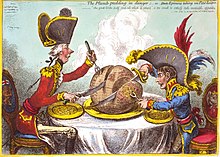
Napoleon has become a worldwide cultural icon who symbolises military genius and political power. Since his death, many towns, streets, ships, and even cartoon characters have been named after him. He has been portrayed in hundreds of films and discussed in thousands of biographies.[135]
During the Napoleonic Wars he was taken seriously by the British as a dangerous tyrant, poised to invade. A nursery rhyme warned children that Bonaparte ravenously ate naughty people; the 'bogeyman'.[136] British propaganda of the time depicted Napoleon as much smaller than average height and this image persists. Confusion about his height results from the difference between the French pouce and British inch - 2.71 and 2.54 cm respectively; he was 1.7 m tall, just under average height for a Frenchman at the time.[note 15]
In contradiction to his sizable military and political accomplishments, the stock character of Napoleon is a comically short "petty tyrant" and this has become a cliché in popular culture. He is often portrayed wearing a comically large bicorne and one hand tucked inside his coat - a reference to the 1812 painting by Jacques-Louis David. Napoleon's name has been lent to the Napoleon complex, a colloquial term that describes an inferiority complex said to affect some short people.
Legacy

Napoleonic Code
The Napoleonic code was adopted throughout much of Europe and remained in force after Napoleon's defeat. Napoleon said: "My true glory is not to have won 40 battles...Waterloo will erase the memory of so many victories. ... But...what will live forever, is my Civil Code." [138] The Code still has importance today in a quarter of the world's jurisdictions including in Europe, the Americas and Africa.[139] Dieter Langewiesche described the code as a "revolutionary project" which spurred the development of bourgeoisie society in Germany by extending the right to own property and breaking feudalism. Napoleon reorganised what had been the Holy Roman Empire, made-up of more than a thousand entities, into a more streamlined forty-state Confederation of the Rhine, providing the basis for the German Confederation and the unification of Germany into a German Empire in 1871.[140] The movement of national unification in Italy was precipitated by Napoleonic rule in the country.[141] These changes contributed to the development of nationalism and the Nation state.[142]
Metric system
Even though the official introduction of the metric system in September 1799 was never popular in large sections of French society, Napoleon's rule greatly aided adoption of the new standard across the French sphere of influence. Napoleon ultimately took a retrograde step in 1812, as he passed legislation to return France to its traditional units of measurement, but these were decimalised and the foundations were laid for the definitive introduction of the metric system across Europe in the middle of the 19th century.[143]
Religion
Napoleon emancipated Jews from laws restricting them to ghettos, and their rights to property, worship, and careers. Despite the anti-semitic reaction to Napoleon's policies from foreign governments and within France, he believed emancipation would benefit France by attracting Jews to the country.[144] He stated that, "I will never accept any proposaIs that will obligate the Jewish people to leave France, because to me the Jews are the same as any other citizen in our country. It takes weakness to chase them out of the country, but it takes strength to assimilate them."[145] Anti-semitism was socially acceptable at that time and his policy was contrary to accepted opinion. He was seen as so favourable to the Jews that the Russian Orthodox Church formally condemned him, as a false messiah who had conspired with Jews against the Christian faith.[146]
Napoleon was less positive about how he would be perceived by the Christian world. Henry Parry Liddon observed that Napoleon, during his exile on St. Helena, compared himself unfavourably to Christ. Napoleon said to Count Montholon that while he and others such as "Alexander, Caesar and Charlemagne" founded vast empires, their achievements relied on force, Jesus "founded his empire on love."[147]
Bonapartism
In French political history, Bonapartism has two meanings. The term can refer to people restored the French Empire under the House of Bonaparte including Napoleon's Corsican family and his nephew Louis. Napoleon left a Bonapartist dynasty which ruled France again; Louis became Napoleon III of France, Emperor of the Second French Empire and was the first President of France. In a wider sense, Bonapartism refers to a political movement that advocates the idea of a strong and centralized state, based on popular support.[148]
Admirers and critics
Napoleon ended lawlessness and disorder according to historian John Abbott.[149] However, Napoleon has been compared to later autocrats: his opponents state that he was not significantly troubled when faced with the prospect of war and death for thousands; turned his search for undisputed rule into a series of conflicts throughout Europe and ignored treaties and conventions alike. He was compared to Hitler most famously by the historian Pieter Geyl in 1947.[150]
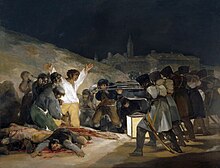
Napoleon institutionalised plunder of conquered territories: French museums contain art stolen by Napoleon's forces from across Europe. Artefacts were brought to the Louvre in Paris for a grand central Museum; his example would later serve as inspiration for more notorious imitators.[152] He was considered a tyrant and usurper, by his opponents.[153] When other countries offered terms to Napoleon which would have restored France's borders to positions that would have delighted his predecessors, he refused compromise and only accepted surrender. His supporters insist the offers were insincere however, as the aim of the powers concerned was his destruction. Critics of Napoleon argue his true legacy was a loss of status for France and needless deaths. Historian Victor Davis Hanson writes, "After all, the military record is unquestioned - 17 years of wars, perhaps six million Europeans dead, France bankrupt, her overseas colonies lost."[154] Napoleon's initial success may have sowed the seeds for his downfall; not used to such catastrophic defeats in the rigid power system of 18th century Europe, nationalists found life under the French administration intolerable, this sparked revolts, wars, and instability that plagued the continent in the period to 1815.
Internationally there are those who admire his accomplishments.[note 16] Vincent Cronin notes that much criticism of Napoleon is reliant on the premise that he was responsible for the wars associated with him, that he was the cause of conflict rather than that France was the victim of a series of coalitions that aimed to destroy the ideals of the revolution.[156]
Warfare

In the field of military organisation, he borrowed from previous theorists such as Jacques Antoine Hippolyte, Comte de Guibert, and the reforms of preceding French governments and developed much of what was already in place. He continued, for example, the Revolution's policy of promotion based primarily on merit.[157] Corps replaced divisions as the largest army units, artillery was integrated into reserve batteries, the staff system became more fluid, and cavalry once again became an important formation in French military doctrine.[157] Though he is credited with the introduction of conscription, one of the restored monarchy's first acts was to end it.[158]
Weapons and technology remained largely static through the Revolutionary and Napoleonic eras, but 18th century operational mobility underwent significant change.[159] Napoleon's biggest influence was in the conduct of warfare. He was regarded by the influential military theorist Carl von Clausewitz as a genius in the operational art of war.[160] A new emphasis towards the destruction, not just outmanoeuvring, of enemy armies emerged. Invasions of enemy territory occurred over broader fronts which made wars costlier and more decisive - a phenonemon that came to be known as Napoleonic warfare, though he did not give it this name. The political aspects of war had been revolutionised, and defeat for a European power now meant more than the loss of isolated enclaves. Near-Carthaginian peaces intertwined whole national efforts, economic and militaristic, into collisions that upset international conventions.[161] Historians place Napoleon as one of the greatest military strategists in history, alongside Alexander the Great and Julius Caesar. Wellington, when asked who was the greatest general of the day, answered: "In this age, in past ages, in any age, Napoleon."[162]
Notes
- ^ Neither Napoleone nor his family used the nobiliary particle di.
- ^ At Brienne, Napoleon first met the Champagne maker Jean-Rémy Moët. They became friends and Napoleon would later frequently stay at Moët's estate. Victorious French armies were known for indulging in sabrage.[8]
- ^ Aside from his name, there does not appear to a connection between him and Napoleon's theorem.[10]
- ^ He was mainly referred to as Bonaparte until he became First Consul for life.
- ^ "Bonaparte's principle was...to look upon religions as the work of men, but to respect them everywhere as a powerful engine of government...If Bonaparte spoke as a Mussulman (Muslim), it was merely in his character of a military and political chief in a Mussulman country. To do so was essential to his success, to the safety of his army, and...to his glory...In India he would have been for Ali, at Thibet for the Dalai-lama, and in China for Confucius."[41]
- ^ Claude Ribbe advances the thesis that the French used gas chambers.[62]
- ^ Claims he seized the crown out of the hands of Pope Pius VII during the ceremony - to avoid subjecting himself to the authority of the pontiff - are apocryphal; the coronation procedure had been agreed in advance. Napoleon gave the pope a tiara following the ceremony. At Milan Cathedral on 26 May 1805, Napoleon was crowned King of Italy with the Iron Crown of Lombardy.
- ^ The first Polish war was the Bar Confederation uprising by Polish nobles against Russia. Polish patriots wanted the Russian part of partitioned Poland to be incorporated into the Duchy of Warsaw and a new Kingdom of Poland created, though this was rejected by Napoleon, who feared it would bring Prussia and Austria into the war against France.
- ^ See Borodino article for comparisons to the Battle of the Somme.
- ^ A custom in which householders place candles in street-facing windows to herald good news.[109]
- ^ It was customary to cast a death mask or mold of a leader. Four genuine death masks of Napoleon are known to exist: one in The Cabildo, a state museum located in the New Orleans, one in a Liverpool museum, another in Havana and one in the library of the University of North Carolina.[116]
- ^ Egyptian porphyry used for the tombs of Roman emperors was unavailable, so red quartzite was obtained from Russian Finland, this elicited protests from those who still remembered the Russians as enemies.
- ^ A 2004 group of researchers claimed treatments imposed on the emperor caused death by Hypokalemia.[122]
- ^ The body can tolerate large doses of arsenic if ingested regularly, and arsenic was a fashionable cure-all.[124]
- ^ Napoleon's height was 5 ft 2 French inches according to Antommarchi at Napoleon's autopsy and British sources put his height at 5 ft 7 ins: both equivalent to 1.7 m.[137] Napoleon surrounded himself with tall bodyguards and his nickname of le petit caporal has added to the confusion, as non-Francophones have mistakenly interpreted petit as its most common meaning of "small". In fact, it was an affectionate term that reflected his reported camaraderie with ordinary soldiers.
- ^ International Napoleonic Congresses are held regularly including participation by members of the French and American military, French politicians and scholars from different countries.[155]
Citations
- ^ McLynn 1998, p.6
- ^ McLynn 1998, p.2
- ^ Cronin 1994, p.20–21
- ^ "Cathedral - Ajaccio". La Fondation Napoléon. Retrieved 31 May 2008.
- ^ a b c Roberts 2001, p.xvi
- ^ McLynn 1998, p.18
- ^ a b Hibbert 1998, p.21-2
- ^ Kladstrup 2005, p.61-8
- ^ Asprey 2000, p.13
- ^ Wells 1992, p.74
- ^ McLynn 1998, p.23
- ^ McLynn 1998, p.26
- ^ McLynn 1998, p.37
- ^ McLynn 1998, p.55
- ^ McLynn 1998, p.61
- ^ a b c d e f Roberts 2001, p.xviii
- ^ Schom 1998, p.16
- ^ Schama 1989, p.688
- ^ McLynn 1998, p.103
- ^ Schom 1998, p.25
- ^ McLynn 1998, p.92
- ^ McLynn 1998, p.93
- ^ a b McLynn 1998, p.96
- ^ Johnson 2002, p.27
- ^ McLynn 1998, p.102
- ^ McLynn 1998, p.129
- ^ Schama 1989, p.738
- ^ McLynn 1998, p.132
- ^ McLynn 1998, p.145
- ^ McLynn 1998, p.142
- ^ Harvey 2006, p.179
- ^ McLynn 1998, p.135
- ^ Hanley 2005, Chapter 3
- ^ Schom 1998, pp.69–70
- ^ Schom 1998, p.87
- ^ Schom 1998, pp.72–73
- ^ a b Alder 2002
- ^ Youssef 1998. Cole 2007.
- ^ McLynn 1998, p.175
- ^ Cherfils 1914, pp.105 and 125
- ^ "Bonaparte and Islam". George Mason University Center for History and New Media. Retrieved 11 October 2008.
- ^ Smith 1998, p.140
- ^ a b c d e f g Roberts 2001, p.xx
- ^ Schom 1998, pp.139–144
- ^ Roberts 1995, p.147-160
- ^ McLynn 1998, p.189
- ^ McLynn 1998, p.193
- ^ Schom 1998, pp.176–179
- ^ a b c Connelly 2006, p.57
- ^ Schom 1998, pp.186–188
- ^ Schom 1998, p.194
- ^ McLynn 1998, p.215
- ^ McLynn 1998, p.224
- ^ Edwards 1999, p.55
- ^ McLynn 1998, p.290
- ^ Blaufarb 2007, p.101-2
- ^ McLynn 1998, 255
- ^ Chandler 2002, p.51
- ^ Jackson 2004, p.33
- ^ McLynn 1998, p.235
- ^ McLynn 1998, p.265
- ^ Ribbe 2007
- ^ Connelly 2006, p.70
- ^ Bruce 1995, p.321–3
- ^ Gay 1973, p.512
- ^ a b McLynn 1998, p.297
- ^ McLynn 1998, p.321
- ^ Goetz 2005, p.301
- ^ McLynn 1998, p.350
- ^ Cronin 1994, p.344
- ^ McLynn 1998, p.356
- ^ McLynn 1998, p.426
- ^ McLynn 1998, p.497
- ^ Gates 2001, p.20
- ^ Chandler 1995, p.631
- ^ Harvey 2006, p.631
- ^ Gates 2001, p.177
- ^ Gates 2001, p.467
- ^ Castle 1994, p.90
- ^ McLynn 1998, p.422
- ^ McLynn 1998, p.470
- ^ McLynn 1998, p.433-5
- ^ McLynn 1998, p.472
- ^ McLynn 1998, p.378
- ^ Riehn 1991, p.24
- ^ Riehn 1991, p.81
- ^ Harvey 2006, p.773
- ^ Markham 1988, p.194
- ^ McLynn 1998, p.519
- ^ Markham 1988, p.190 and 199
- ^ Zamoyski 2004, p.537
- ^ McLynn 1998, p.541
- ^ McLynn 1998, p.549
- ^ McLynn 1998, p.565
- ^ Chandler 1995, p.1020
- ^ Fremont-Barnes 2004, p.14
- ^ Gates 2003, p.259
- ^ Schom 1998, p.702
- ^ Jones 1995
- ^ McLynn 1998, p.604
- ^ McLynn 1998, p.605
- ^ Hibbert 1998, p.403
- ^ Chesney 2006, p.35
- ^ Cordingly 2004, p.254
- ^ Balcombe 1845
- ^ Thomson 1969, p.77-9
- ^ McLynn 1998, p.644
- ^ a b McLynn 1998, p.642
- ^ Woodward 2005, p.51-9
- ^ Gregory 1996, p.140
- ^ Macaulay 1986, p.141
- ^ Wilkins 1972
- ^ McLynn 1998, p.651
- ^ a b c d McLynn 1998, p.655
- ^ Wilson 1975, p.293–5
- ^ Fulghum 2007
- ^ McLynn 1998, p.655
- ^ Driskel 1993, p.168
- ^ McLynn 1998, p.656
- ^ Johnson 2002, p.180–1
- ^ a b c Cullen 2008, p.146-48
- ^ Randerson 2004
- ^ a b Cullen 2008, p.156
- ^ Cullen 2008, p.50
- ^ Cullen 2008, p.161
- ^ McLynn 1998, p.117
- ^ McLynn 1998, p.271
- ^ McLynn 1998, p.118
- ^ McLynn 1998, p.188
- ^ McLynn 1998, p.100
- ^ McLynn 1998, p.663
- ^ a b McLynn 1998, p.630
- ^ McLynn 1998, p.423
- ^ Lowndes 1943
- ^ "Napoleon Bonaparte (Character)". IMDB. Retrieved 12 October 2008.
- ^ Krensky 2007, p.11
- ^ Dunan 1963
- ^ Wanniski 1998, p.184
- ^ Wood 2007, p.55
- ^ Scheck 2008, Chapter: The Road to National Unification
- ^ Astarita 2005, p.264
- ^ Alter 2006, p.61–76
- ^ O'Connor 2003
- ^ McLynn 1998, p.436
- ^ Schwarzfuchs 1979, p.50
- ^ Cronin 1994, p.315
- ^ Liddon 1866
- ^ Outhwaite 2003 p.50
- ^ Abbott 2005,p.3
- ^ Geyl 1947
- ^ Bertman 2002
- ^ Baude 2004
- ^ McLynn 1998, p.666
- ^ Hanson 2003
- ^ "Call for Papers: International Napoleonic Society, Fourth International Napoleonic Congress". La Fondation Napoléon. Retrieved 27 June 2008.
- ^ Cronin 1994, pp.342-3
- ^ a b Archer 2002, p.397
- ^ Flynn 2001, p.16
- ^ Archer 2002, p.383
- ^ Archer 2002, p.380
- ^ Archer 2002, p.404
- ^ Roberts 2001, p.272
References
- Abbott, John (2005). Life of Napoleon Bonaparte. Kessinger Publishing. ISBN 1417970634.
- Alder, Ken (2002). The Measure of All Things - The Seven-Year Odyssey and Hidden Error That Transformed the World. Free Press. ISBN 074321675X.
- Alter, Peter (2006). Tim Blanning and Hagen Schulze (ed.). Unity and Diversity in European Culture c. 1800. Oxford University Press. ISBN 0197263828.
- Archer, Christon I. (2002). World History of Warfare. University of Nebraska Press. ISBN 0803244231.
{{cite book}}: Unknown parameter|coauthors=ignored (|author=suggested) (help) - Asprey, Robert (2000). The Rise of Napoleon Bonaparte. Basic Books. ISBN 0465048811.
- Astarita, Tommaso (2005). Between Salt Water And Holy Water: A History Of Southern Italy. W. W. Norton & Company. ISBN 0393058646.
- Balcombe Abell, Lucia Elizabeth (1845). Recollections of the Emperor Napoleon. J. Murray.
- Baude, Leora (29 April 2007). "Plundered Treasure". Herald Times. Retrieved 11 January 2008.
- Bertman, Sandra (2002). "Execution of the Defenders of Madrid, 3rd May 1808". New York University. Retrieved 18 November 2008.
- Blaufarb, Rafe (2007). Napoleon: Symbol for an Age, A Brief History with Documents. Bedford. ISBN 0312431104.
- Bruce, Evangeline (1995). Napoleon & Josephine, An Improbable Marriage. Scribners. ISBN 0806522615.
- Castle, Ian (1994). Aspern & Wagram 1809: Mighty Clash Of Empires. Osprey. ISBN 1855323664.
- Chandler, David (1995). The Campaigns of Napoleon. Simon & Schuster. ISBN 0025236601.
- Chandler, David (2002). Napoleon. Leo Cooper. ISBN 0850527503.
- Cherfils, Christian (1914). Bonaparte and Islam. Pedone.
- Chesney, Charles (2006). Waterloo Lectures:A Study Of The Campaign Of 1815. Kessinger Publishing. ISBN 1428649883.
- Cole, Juan (2007). Napoleon's Egypt: Invading the Middle East. Palgrave Macmillan. ISBN 1403964319.
- Connelly, Owen (2006). Blundering to Glory: Napoleon's Military Campaigns. Rowman & Littlefield. ISBN 0742553183.
- Cordingly, David (2004). The Billy Ruffian: The Bellerophon and the Downfall of Napoleon. Bloomsbury. ISBN 158234468X.
- Cronin, Vincent (1994). Napoleon. HarperCollins. ISBN 0006375219.
- Cullen, William (2008). Is Arsenic an Aphrodisiac?. Royal Society of Chemistry. ISBN 0854043632.
- Driskel, Paul (1993). As Befits a Legend. Kent State University Press. ISBN 0873384849.
- Dunan, Marcel (1963). "Napoleon's height" (in French). La Fondation Napoléon. Retrieved 11 January 2009.
- Edwards, Catharine (1999). Roman Presences. Cambridge University Press. ISBN 052159197X.
- Flynn, George Q. (2001). Conscription and democracy: The Draft in France, Great Britain, and the United States. Greenwood Publishing Group. ISBN 031331912X.
- Fremont-Barnes, Gregory (2004). The Napoleonic Wars: The Rise and Fall of an Empire. Osprey. ISBN 1841768316.
{{cite book}}: Unknown parameter|coauthors=ignored (|author=suggested) (help) - Fulghum, Neil (2007). "Death Mask of Napoleon". University of North Carolina. Retrieved 4 August 2008.
- Gates, David (2001). The Spanish Ulcer: A History of the Peninsular War. Da Capo Press. ISBN 0306810832.
- Gates, David (2003). The Napoleonic Wars, 1803-1815. Pimlico. ISBN 0712607196.
- Gay, Peter (1973). Modern Europe to 1815. Harper & Row. ISBN 0060422831.
{{cite book}}: Unknown parameter|coauthors=ignored (|author=suggested) (help) - Goetz, Robert (2005). 1805: Austerlitz: Napoleon and the Destruction of the Third Coalition. Greenhill Books. ISBN 1853676446.
- Geyl, Pieter (1982) [1947]. Napoleon For and Against. Penguin Books.
- Gregory, Desmond (1996). Napoleon's Jailer. Fairleigh Dickinson Univ Press. ISBN 0838636578.
- Hanley, Wayne (2005). The Genesis of Napoleonic Propaganda, 1796-1799. Columbia University Press. ISBN 0231124562.
- Hanson, Victor Davis (2003). "The Claremont Institute: The Little Tyrant, A review of Napoleon: A Penguin Life". The Claremont Institute. Retrieved 30 May 2008.
- Harvey, Robert (2006). The War of Wars. Robinson. ISBN 9781845296353.
- Hibbert, Christopher (1998). Waterloo: Napoleon's last campaign. Wordsworth Editions. ISBN 1853266876.
- Jackson, John (2004). Race, Racism, and Science. ABC-CLIO. ISBN 1851094482.
- Johnson, P. (2002). Napoleon: A life. Penguin Books. ISBN 0670030783.
- Jones, Meg (23 May 1995). "Elba: Why did Napoleon ever leave this island paradise". Milwaukee Sentinel. Retrieved 28 May 2008.
- Kladstrup, Don (2005). Champagne:How the World's Most Glamorous Wine Triumphed Over War and Hard Times. William Morrow. ISBN 0060737921.
{{cite book}}: Unknown parameter|coauthors=ignored (|author=suggested) (help) - Krensky, Stephen (2007). The Bogeyman. Lerner Publishing Group. ISBN 0822585219.
- Liddon, Parry (1866). "The Divinity of Our Lord and Savior Jesus Christ - The Bampton Lectures". Holy, Holy, Holy: the Biblical Doctrine of the Trinity. Retrieved 11 January 2009.
- Lowndes, Marie Adelaide Belloc (1943). Where Love And Friendship Dwelt. Macmillan.
- Macaulay, Neill (1986). Dom Pedro: The Struggle for Liberty in Brazil and Portugal, 1798-1834. Duke University Press. ISBN 0822306816.
- Markham, Felix (1988). Napoleon. Mass Market Paperback. ISBN 0451627989.
- McLynn, Frank (1998). Napoleon. Pimlico. ISBN 0712662472.
- O'Connor, J (2003). "The history of measurement". St Andrew's University. Retrieved 18 July 2008.
{{cite web}}: Unknown parameter|coauthors=ignored (|author=suggested) (help) - Outhwaite, William (2003). The Blackwell Dictionary of Modern Social Thought. Blackwell. ISBN 0631221646.
- Peterson, Robert (1995). "Insects, Disease, and Military History: The Napoleonic Campaigns and Historical Perception". American Entomologist (vol.41). Entomological Society of America.
{{cite journal}}:|issue=has extra text (help) - Randerson, James (23 July 2004). "Doctors may have killed Napoleon". New Scientist. Retrieved 11 August 2008.
- Ribbe, Claude (2007). Napoleon's Crimes: A Blueprint for Hitler. Oneworld Publications. ISBN 1851685332.
- Riehn, Richard (1991). 1812 Napoleon's Russian Campaign. Wiley. ISBN 0471543020.
- Roberts, Andrew (2001). Napoleon and Wellington. Weidenfeld and Nicholson. ISBN 0297646079.
- Schama, Simon (2004). Citizens. Penguin. ISBN 0141017279.
- Scheck, Raffael (2008). Germany, 1871-1945: A Concise History. Berg. ISBN 184520817X.
- Schom, Alan (1998). Napoleon Bonaparte: A Life. Harper Perennial. ISBN 0060929588.
- Schwarzfuchs, Simon (1979). Napoleon, the Jews and the Sanhedrin. Routledge. ISBN 0197100236.
- Smith, Digby (1998). The Greenhill Napoleonic Wars Data Book. Greenhill Books. ISBN 1853672769.
- Thomson, Kathleen (1969). "Balcombe, Alexander Beatson (1811-77)". Australian Dictionary of Biography Online. Retrieved 27 May 2008.
- Wanniski, Jude (1998). The Way the World Works. Regnery Gateway. ISBN 0895263440.
- Wells, David (1992). The Penguin Dictionary of Curious and Interesting Geometry. Penguin Books. ISBN 0140118136.
- Wilkins, William (1972) [1944]. Napoleon's Submarine. New English Library. ISBN 0450010287.
- Wilson, J (8 August 1975). "Dr. Archibald Arnott: Surgeon to the 20th Foot and Physician to Napoleon" (vol.3). British Medical Journal. Retrieved 7 June 2008.
{{cite journal}}:|issue=has extra text (help); Cite journal requires|journal=(help) - Wood, Philip (2007). The Law and Practice of International Finance Series. Sweet & Maxwell. ISBN 1847032109.
- Woodward, Chris (2005). "Napoleon's Last Journey". History Today. Retrieved 12 July 2008.
{{cite web}}: Unknown parameter|month=ignored (help) - Youssef, Ahmed (1998). The Fascination of Egypt: From the Dream to the Project (in French). Harmattan. ISBN 2738466745.
- Zamoyski, Adam (2004). Moscow 1812: Napoleon's Fatal March. HarperCollins. ISBN 0007123752.
Further reading
External links
- [[s:|]] – via Wikisource.
{{citation}}: Check|title-link=value (help) - [[s:|]] – via Wikisource.
{{citation}}: Check|title-link=value (help) - Memoirs of Napoleon at Project Gutenberg
- J. G. Lockhart
- The History of Napoleon Buonaparte at Project Gutenberg
- John Holland Rose
- The Life of Napoleon I at Project Gutenberg
- William Milligan Sloane
- The Life of Napoleon I. at Project Gutenberg Vol. 1/4
- William Milligan Sloane
- The Life of Napoleon I. at Project Gutenberg Vol. 3/4
- BBC profile
- Biography by the US Public Broadcasting Service
- Napoleon 101, podcast by J. David Markham
- Napoleon Series
- International Napoleonic Society
- Template:Find A Grave
- Edward Winter, Napoleon Bonaparte and Chess (1998)
Titles
Template:Persondata {{subst:#if:Napoleon 1 of France|}} [[Category:{{subst:#switch:{{subst:uc:1769}}
|| UNKNOWN | MISSING = Year of birth missing {{subst:#switch:{{subst:uc:1821}}||LIVING=(living people)}}
| #default = 1769 births
}}]] {{subst:#switch:{{subst:uc:1821}}
|| LIVING = | MISSING = | UNKNOWN = | #default =
}}
Template:Link FA Template:Link FA Template:Link FA Template:Link FA Template:Link FA Template:Link FA Template:Link FA
- Living people
- 1821 deaths
- Cancer deaths in Saint Helena
- Culture heroes
- Deaths from stomach cancer
- Dictatorship
- First French Empire
- French commanders of the Napoleonic Wars
- French emperors
- French exiles
- French Roman Catholics
- French people of Italian descent
- House of Bonaparte
- Knights of the Golden Fleece
- Leaders who took power by coup
- Members of the French Academy of Sciences
- Military leaders of the French Revolutionary Wars
- Napoleon
- People excommunicated by the Roman Catholic Church
- People from Ajaccio
- Princes of Andorra



